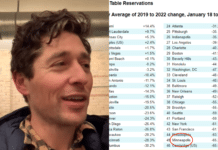Last week, I asked why the state government was hiding the questions its COVID-19 tracers are asking. I had been told that:
The three questions that they ask as part of their contact tracing questionnaire are in the 14 days prior to onset of symptoms, did you (1) visit a bar/restaurant; (2) attend a large gathering; or (3) come in contact with someone who was positive.
As I wrote, given these questions:
… we would expect to get a higher number of cases linked to bars and restaurants because they are the only kind of establishments we are asking about. If somebody contracted COVID-19 at Target or Walmart say, the state’s tracers would never find out because they don’t bother to ask. The questions assume that the only place you can contract COVID-19 is at either a bar or restaurant or a large gathering. By excluding all other options, they make it more likely that these places will be over-represented as vectors of transmission.
So, is this what Minnesota’s contact tracers are asking? At my request, Scott Johnson of Powerline put the question to the Department of Health this week and received the following written reply:
5. Question: Please provide the questionnaire or outline used by staff to interview subjects for the purpose of COVID-19 contact tracing.
Response: We have not routinely provided the specific interview questions to reporters because the questions can change, depending on the course of the pandemic. However the interview forms follow a standard outline based on best practices and MN law. The outline of the interview is: 1) Tennessen (privacy) statement), 2) demographic information, 3) living setting, 4) illness history, underlying health conditions, 5) potential exposures during the incubation period, 6) infectious period/release from isolation, 7) assess contacts/potential exposures, 8) exposure notification app information, 9) need for essential services, 10) prevention messages, 11) additional demographics and isolation address.
This doesn’t answer Johnson’s question. We are told that the contact tracers ask about “potential exposures during the incubation period,” but we aren’t told what they ask.
Happily, a contact tracer contacted me recently and shared the questions they are given to ask. The image below is a screenshot:

As we can see, the tip off was substantially correct. The contact tracers only ask about visits to restaurants and bars, salons or spas, sports events, and gyms, so those are the only visits they record. As a result, all of these are overrepresented in the numbers. If your aim is to find out what the vectors of transmission actually are, this is a very poorly designed question. If, on the other hand, you were trying to make the case that these venues were particular vectors, this is exactly the sort of question you would ask.
Presumably the Department of Health’s contact tracers are calling thousands of people each week and asking them these questions. Given this, their desire to hide the questions that were being asked so widely was always strange. Perhaps they were embarrassed?
– – –
John Phelan is an economist at the Center of the American Experiment. This article was republished with permission from the Center of the American Experiment.


















